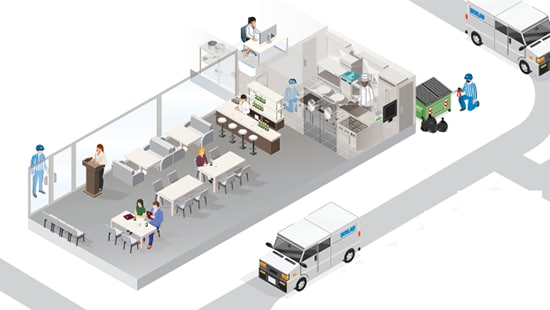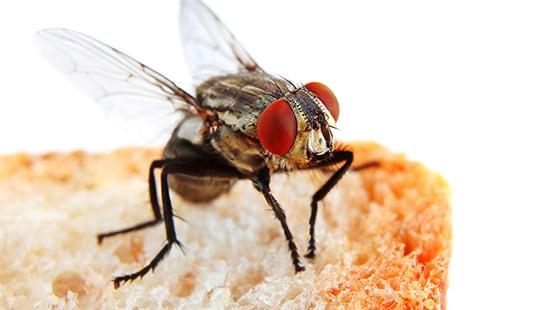
Benefit of Outside-In Approach
Implementing a comprehensive programme utilizing an Outside-In Approach can greatly improve your efforts towards large fly prevention in your facility.
Benefit of Outside-In Approach
Implementing a comprehensive programme utilizing an Outside-In Approach can greatly improve your efforts towards large fly prevention in your facility. Large flies, also known as filth flies, include houseflies, bottle/blow flies and flesh flies. An Outside-In Approach focuses on finding the root cause of large fly activity and solving issues before flies reach the interior. This approach requires a good partnership between you and your pest management provider. There are three areas of focus working from the outside to the inside of your facility:
Reduce fly pressure on the exterior. Good sanitation on the exterior is the key to reducing fly pressure. Targeted treatment of exterior surfaces and use of Ecolab Fly Stations in areas where large flies congregate (such as in dumpster corrals and garbage areas) will help reduce the number of flies near entrances, reducing large fly pressure.
Minimise entry opportunities. Open doors are the primary route for large flies to gain access to the inside of your facility. Finding ways to minimise open-door time is essential, but often there is no choice. In areas where there is high exterior pressure and doors are opened repeatedly, other options such as vestibules, air curtains, plastic strips etc. must be considered.
Eliminate activity on the interior. If large flies are gaining access to the interior of the facility, the best options are to look for better ways to ‘reduce pressure on the exterior’ and ‘minimise entry opportunities.’ Killing flies inside is the least effective way to address a large fly issue. However, large fly activity on the inside can be addressed by installing insect light traps and targeted treatments to fly resting surfaces. A strong partnership with your pest service provider can lead to an effective large fly plan using the Outside-In Approach.
More Resources
Facts About Large Flies ("House Flies")
Large flies, also known as filth flies, include houseflies, bottle/blow flies and flesh flies. Understanding the biology and behavior of these common types of large flies can help with fly prevention in your facility.

Large Flies and Food Safety
Large flies including houseflies, bottle or blow flies and flesh flies are also called “filth flies” because they breed in filth such as manure, human excreta, dumpsters, garbage, and decaying vegetation, causing a food safety risk.

How to Prevent Large Fly Problems
To protect your business from the health risk posed by large flies such as houseflies and bottle/blow flies, there are steps you and your pest management provider can take to minimise food safety risks.


